AMD Entry-level PC
Two years ago our Entry AMD CPU was single core, last December a bit more money bought a 2.6GHz dual-core system, and today's AMD Entry system uses a Black Edition unlocked 2.7GHz dual-core. It's great to see the increased value in an economy that forces most buyers to look closely at price.
With memory so cheap we have continued our recommendation of 4GB at a 2x2GB kit price of just $27. For this guide we now have the option of 4GB of DDR2-800 with very fast 4-4-4 timings, thanks to the continuing use of rebates as a marketing tool by memory manufacturers. You can buy 2GB and save $18, but that money is well spent in doubling memory. The hard drive remains a 500GB. Finally, the monitor choice has moved up from a widescreen 17" to a higher resolution widescreen 19" - at just $10 more than the previous $100 price. LCD prices have been dropping rapidly and monitor value improves with each new Buyers' Guide in the past year.
| AMD Entry-level PC | ||
| Hardware | Component | Price |
| Processor | Athlon X2 7750 Black Edition Kuma (Dual-core 2.7GHz, 65nm, 95W, 2x512KB L2, AM2+) |
$60 |
| Cooling | CPU Retail HSF | - |
| Video | On-Board | - |
| Motherboard | ASRock A780GMH/128M 780G AM2+/AM3 HDMI | $72 |
| Memory | Patriot Viper Model PVS24G6400LLK 4GB DDR2-800 4-4-4 ($52 less $25 Rebate) |
$27 |
| Hard Drive | WD Caviar GP WD5000AACS 500GB | $55 |
| Optical Drive | Sony Optiarc Model AD-7240S-OB 24X DVDRW SATA | $24 |
| Audio | On-Board | - |
| Case | SIGMA La Vie LBYWBP Leather Mid-Tower w/ 500W PSU ($65 less $20 Rebate) |
$45 |
| Power Supply | 500W Included with Case | - |
| Base System Total | $283 | |
| Display | Acer X193W+BD 19" 5ms Widescreen LCD (1680x1050) | $110 |
| Speakers | Cyber Acoustics CA3090WB 2.1 Gaming Speakers | $16 |
| Input | Microsoft CA9-00001 PS/2 Keyboard and Optical Mouse | $17 |
| Operating System | Microsoft Vista Home Premium SP1 (for System Builders) | $99 |
| Complete System Bottom Line | $525 | |
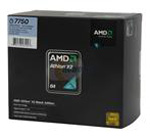 |
Prices on all processors are continuing to drop with the aggressive price war between Intel and AMD in entry to upper midrange processors. The $60 Athlon X2 7750BE is a fast 2.7GHz Kuma dual-core at a price of just $60. It is not just faster than in the last guide, but it's also a Black Edition (unlocked) CPU. Most have been easily running at 3.0GHz just by increasing the multiplier. If you want even more power the new Athlon 64 7850 (2.8GHz) is a good choice at $69, or a Phenom 8750 triple-core Black Edition is a terrific value at just $27 more at $87. However, for most users the Athlon 64 X2 7750 provides plenty of power for an entry system. About the only real drawback is that the latest Athlon X2 parts are still using 65nm process technology and come from harvested Phenom chips (i.e. with two non-functional cores), so power draw will be higher than the latest 45nm parts.
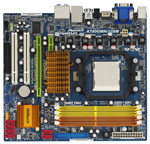 |
The 780G chipset is still going strong and manufacturers are currently updating to second-generation designs based on this IGP workhorse. One of the best second-generation 780G boards in this price category is the ASRock A780GMH/128M. ASRock has done a masterful job in updating their previous GM-LE series of boards. From the new packaging design and accessory kit components to the revised layout, we would be hard pressed to find a better value in this price range. The A780GMH/128M utilizes the AMD/ATI Radeon 3200 integrated graphics engine along with 128MB of Side Port memory to deliver excellent integrated performance. This board features the revised SB710 Southbridge that features six 3Gb/s SATA ports with RAID 0/1/10 support, 7.1 HD audio from the VIA VT1708S codec, 10 USB 2.0 ports, and Gigabit LAN with the revised Realtek RTL8111DL controller. The board has a single PCI-E x16 slot, one PCI-E x1 slot, and two PCI slots along with support for 16GB of memory. ASRock now includes three video output options with D-Sub, DVI-D, and HDMI ports all available on the I/O panel.
All current AM2/AM2+/AM3 processors are supported via an overclocking friendly BIOS. The only (minor) drawbacks with the board are the lack of IEEE 1394a capability and fan control options for the system fan headers. The quality of components utilized in the board is excellent at this price point and we have put the board through a grueling 30-day test period without any problems to date. This board is worthy of an award and we will have a complete review on it shortly, but in the meantime it carries our highest recommendation in this price category.
 |
There always seems to be some version of the Sigma mid tower with the Sigma 500W PSU on sale or rebate. The case and power supply choice for this guide is the Sigma La Vie Leather Black. This case and power supply are currently on sale for $45 after a $20 rebate. Sigma makes both decent cases and decent power supplies sold individually. While no one will mistake this case/PSU combo for one of the premium Sigma offerings, it is still good quality and good value for a very reasonable price. Even if you pay the regular price of $60 to $65 you will get good value in this combo. We have built several entry systems with the Sigma case and PSU and had good results and stable performance. The only caveat is to check out the case when it arrives as shipping can take its toll on the case front door.
If you prefer a smaller case to mate with a Micro ATX motherboard, the HEC 6K28BSOH48D mini tower with a 485W power supply is an option. It is a solid small case with a power supply form HEC, which is one of the world's best PSU makers. You should generally go for the best case and power supply you can reasonably afford, so you should also look at the cases and power supplies recommended for more expensive systems - particularly if you plan to keep your case/PSU and merely upgrade other components in the future.
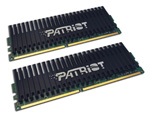 |
With DDR2 prices so very low, we went for 4GB of DDR2-800. This is double last year's entry recommendation for less than half the price. RAM prices as a whole are certainly in the commodity category. There have been small increases in memory prices the last few weeks so you may need to shop a little more for the best price. We recommend the Patriot Viper 4GB DDR2-800 CAS 4 kit, which is just $27 after mail-in rebate. This is faster than our last guide recommendation of CAS5 memory at DDR2-800. You could just as easily choose OCZ, Kingston, Corsair, Crucial, GeIL, Patriot, A-Data or any other quality brand and shop for memory based on a combination of price, timings, and the company's support reputation. Again, if you are truly pinching pennies you can save about $8 by going with 2x1GB DDR2-800 instead at $19 to $20.
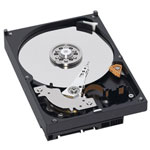 |
Hard drive capacity continues to grow, and we again selected the tried and true Western Digital Caviar 500GB for our entry system. It seems a waste to choose a lower HD capacity when 500GB is now available for under $60. While there are differences between hard drives, outside of running benchmarks most people aren't likely to notice the difference in performance between Western Digital, Seagate, Samsung, Hitachi, and other major brands. All are worthy of consideration if the price per gigabyte (or terabyte) is right.
 |
For the optical drive we went for the newest and fastest Sony 24X DVDRW. With the market moving toward Blu-ray players and 25GB/50GB Blu-ray burners, DVD writers have continued to drop in price. However, a BR player or burner is still a bit rich for an entry system. A Sony DVD writer that supports dual-layer and 24X DVD writes for $24 is a bargain indeed.
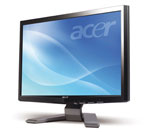 |
The last major component to discuss is the display, and here the tilt must be toward price in an entry system. $100 is a low price for an LCD monitor, but with the prices of LCD monitors dropping $110 now buys a 19" widescreen Acer monitor with a 1680x1050 native resolution. That's a decided step up from the $99 17" LCD chosen in the last Entry System Guide, and the Hanns-G was a 17" 1440x900 LCD. This Acer has the same resolution as most 22" widescreen monitors. You will not give up resolution with this monitor, but things will be a bit smaller.
If your budget allows, you can choose the 21.5" ASUS VH222H with true HD 1920x1080 resolution at $160 after a $10 rebate. 21.5"/22" True HD is today's sweet spot, since the next step up to 23.6"/24" starts around $250. If your budget can stretch to $160, that is money well spent on a 21.5" 16:9 HD wide screen display. We'll have a bit more to say about LCDs on page 4, if you're interested in discussing quality.










65 Comments
View All Comments
jelifah - Thursday, May 14, 2009 - link
Assuming a computer is on an average of 8 hours a day, what cost savings is potentially realized when using a 45nm processor in lieu of a 65nm processor?Heck, I'm still on a 90nm Opteron 170 so anyway I could lie to myself, by 'saving' money upgrading, would be appreciated.
JarredWalton - Thursday, May 14, 2009 - link
From our http://www.anandtech.com/cpuchipsets/showdoc.aspx?...">Athlon X2 7850 vs. Core 2 E5300 article, idle power for the Intel system will be around 123W vs. 126W for the Intel system. Load power favors Intel by a larger margin, at 148W vs. 188W. If you're like most users and average 90% idle/10% load (possibly even less than that), it would work out to an average power draw of 125.5W for Intel and 132.2W for AMD.Eight hours per day, 365.25 days per year, and a cost of $0.10 per kWhr thus yields a total of $38.62 for AMD and $36.67 for Intel (based on these systems). The bigger concern would be potentially higher noise levels under load, I think, unless you plan on running something like Folding@Home in the background.
jelifah - Tuesday, May 19, 2009 - link
Thank you for taking the time to run all the info, Jarred.Roland00 - Thursday, May 14, 2009 - link
Recently LG has created an e-ips panel (an ips panel that allows more light through thus you don't need a larger backlight.)It has already begun to appear in monitors including the dell 2209wa. Unfortunately prices have gone up on this monitor due to high demand, it is now near 280 in price when it was down to 240 when it first launched.
JarredWalton - Thursday, May 14, 2009 - link
At $280, that's probably one of the best compromises between price and quality you're likely to see. It's ironic that Dell doesn't even mention the IPS panel in their technical specs... aren't they proud of that fact?Spacecomber - Thursday, May 14, 2009 - link
They probably don't want to be married to that spec; so, when the supply runs low, they can substitute something else.strikeback03 - Thursday, May 14, 2009 - link
They should be. Is it offered in larger sizes?Roland00 - Thursday, May 14, 2009 - link
LG had (has) plans to make larger size versions of the e-ips panels but I haven't heard anything new for the last 3 months on them. To my knowledge only the dell 2209wa uses the lg e-ips panel.Springfield45 - Thursday, May 14, 2009 - link
Like your editors, I am excited about the 4770 also. I have one sitting on my desk next to my computer. The reason it is not yet IN the computer? I can't find drivers for it. Sapphire (the flavor I purchased) does not have any on their website, nor does AMD. Do you happen to know of a good source for the drivers?Gary Key - Thursday, May 14, 2009 - link
The 9.5 release should be out very shortly (within a week is what I was told) and will offer full HD4770 support under Win7. After testing the 9.5 beta for the last week, I found it improves performance and compatibility across the board over the beta Vista CD drivers.